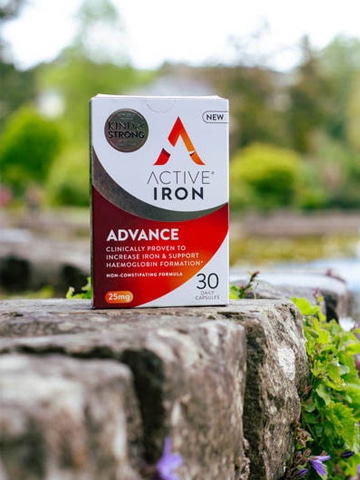Resources for healthcare professionals.
Our healthcare hub has been created specifically for health professionals. Our aim is to equip you with the tools and knowledge you need to help advise and engage your patients and customers, so they can meet their nutritional needs without compromise.
How does Active Iron work?
Most iron supplements dissolve in the stomach. This can lead to oxidation and gut inflammation, which can lead to the common side effects associated with oral iron, such as constipation and nausea. Most liquid iron supplements contain a much lower dose of iron which is why they can avoid these common side effects. Although this is a great benefit, they often do not provide sufficient iron to increase iron levels with some only containing 5mg iron per dose.
Active Iron is different, its groundbreaking whey protein formula targets the right place for absorption, the DMT-1. This helps reduce oxidation thus protecting the gut from inflammation. As a result, Active Iron is highly absorbed compared to other iron supplements¹, making it gentle on the stomach and clinical results have shown that it increases iron levels by 94%². Active Iron’s product doses range from 14mg to 25mg so they are suitable for different patient needs.

Clinically proven research.
Working with a team of Scientists at Dublin’s premier University, Trinity College Dublin, we developed Active Iron, so people could feel the benefits of iron without the negative side effects.
We believe that women have been putting up with the side effects of oral iron for too long. This led us to carry out further clinical research to find out more about the impact that our mode of action had on compliance and tolerability of oral iron.
Continuous Professional Development (CPD).
Active Iron understands that it is a mandatory requirement for Health Care Professionals (HCPs) to complete ongoing professional training and education. That’s why we developed a CPD module where you can learn about the importance of iron throughout women’s lifestages.


We also understand that often there are too few opportunities to access training and development, so we are delighted to partner with the Health Professional Academy to provide education on an independent learning platform.
We have co-developed a dedicated Clinical Hub, full of useful and relevant clinical content, educational material and patient advice for HCPs. We worked with a panel of highly credible academics, clinical reviewers and key opinion leaders to create an academically approved HCP education programme suitable for format CPD accreditation, including an academically approved on-demand video learning module.
Resources.
We want to equip you with the best and most up to date tools and resources to support you in your clinical practice. In this section of our HCP portal you will find; Active Iron product information, patient support materials, educational tools, on demand e-learning videos, healthcare professional testimonials, customer feedback, and latest news including HCP blogs and clinical pearls.
Period health assessment
Use these questions to open up the conversation about period health with your patients/customers
Iron in pregnancy
Written by expert midwife Avril Flynn, this guide can be used by GP’s midwives and maternity professionals
Infographic for midwives
Discover why 84% of midwives recommend Active Iron to their patients throughout their pregnancy journey
Closing the gaps in postpartum care
Marie Louise discusses the vital importance of iron during pregnancy and the postpartum period.
CPD Module
Access our FREE CPD to discover the latest guidelines on the management of iron deficiency amongst pregnant women
Improving the quality of life for women with endometriosis & menorrhagia
This white paper by Dr. Ria Clarke aims to describe some of the common features of endometriosis and menorrhagia.
How Active Iron works
Pharmacist Jess Redden shares insights into the mode of action of Active Iron and discusses the observed outcomes based on her own interactions with patients.
Avoiding Treatment Failure With Iron Supplementation
The purpose of this paper is to inform women, healthcare professionals and birth workers of the importance of iron during pregnancy, treatment failure with traditional iron supplementation and why low dose iron during pregnancy could become the best preventative measure to avoid lapsed usage.
FAQs.
What is Active Iron?
Active Iron’s is a groundbreaking patent protected iron supplement that is highly absorbed compared to oral iron products¹.
How does Active Iron differ from other iron supplements? e.g prescription iron or liquid iron
Active Iron is a food supplement and not a medicine, meaning our products contain 100-179% of the recommended daily allowance of iron, whereas prescription iron has a higher dose. For example, prescription iron may contain 100mg elemental iron. The issue with high dose iron is that it oxidises in the gut and as a result it is poorly absorbed³.
It is this oxidation and poor absorption that causes gastrointestinal side effects such as nausea and constipation in 8/10 people⁴. Typically, 50% of people stop taking iron as a result of these side effects⁵.
Most liquid iron supplements contain a much lower dose of iron which is why they can avoid these common side effects. Although this is a great benefit, they often do not provide sufficient iron to increase iron levels with some only containing 5mg iron per serving.
Active Iron is different. Unlike other oral iron it’s whey protein formula protects the iron from oxidation allowing for 2X better absorption¹. As a result Active Iron is clinically proven to increase iron levels by 94% and is gentle on the stomach, helping to prevent gastrointestinal side effects and allowing for 4X better compliance in taking the product².
What is the recommended dosage of Active Iron?
The recommended dosage of Active Iron may vary depending on the individual’s age, sex, and specific iron deficiency needs. Our product doses range from 14 mg to 25mg, the risk of side effects do not increase with the dose².
Can Active Iron be taken with food?
Active Iron is best taken on an empty stomach to optimise absorption and minimise potential digestive issues. Avoiding the intake of tea, coffee, milk, eggs, whole-grain cereals, and dietary fiber at the same time as taking Active Iron is recommended, as these can reduce iron absorption and potentially contribute to stomach discomfort. It is advisable to take Active Iron with a glass of orange juice (vitamin C enhances iron absorption) one hour before meals or wait for one to two hours after your last meal before taking it.
Are there any common side effects associated with Active Iron?
Active Iron is less likely to cause stomach upset compared to other iron supplements as it is highly absorbed. It is the unabsorbed iron in gut that causes gastrointestinal discomfort. Active Iron has also been clinically proven to be six times less likely to cause gut irritation compared to other iron supplements².
If your patient is experiencing stomach upset, it might be worthwhile to try another box of Active Iron while adhering to the recommended instructions. Active Iron is designed to be gentle on the stomach compared to other iron supplements, but individual experiences may vary. By taking it on an empty stomach and avoiding certain foods or beverages that hinder iron absorption, you can increase the likelihood of a positive experience with Active Iron.
Is Active Iron suitable for everyone?
Active Iron is a low dose product (from 14mg to 25mg) that is highly absorbed compared to other iron supplements¹. We recommend Active Iron only to those who are at risk of developing low iron levels (i.e those with regular periods, pregnant, vegetarians, heavy exercisers) or have low iron levels.
14mg of iron is the recommended daily allowance for iron set by the regulator (EFSA). 14mg would be considered safe based on daily intake for the average person. A tolerable upper limit of 45mg has been recommended for iron and this is based on tolerability of iron products.
There is an inherited condition called haemochromatosis where iron levels build up slowly over many years. Women with periods will have a slower build up than men as there will be iron loss monthly. There is no way of knowing you have this condition unless you have the genetic screening for it.
Can Active Iron be taken during pregnancy or while breastfeeding?
Yes, Active Iron is safe for pregnancy and breasfeeding. It is recommended that Active Iron is taken early in pregnancy to avoid the need for higher dose iron (which can cause side effects) later in pregnancy.
How long does it take for Active Iron to start working?
Active Iron is clinically proven to increase iron and energy levels in six weeks².
Can Active Iron be taken alongside other medications?
Some medications interact with any iron formulation (not only Active Iron) like Omeprazole or other medications that increase stomach pH and reduce iron absorption. All iron forms (not only Active Iron) also reduce levothyroxine hormone absorption. In these cases, a gap of 2-3 hours is recommended between iron supplement and the other medication. Active iron does not interact with contraceptive pills, hormonal replacement therapy (HRT) or multivitamins. Some minerals such as calcium and magnesium can inhibit the absorption or each other when made in one form. We have optimized our multivitamins and minerals formulations to reduce the interaction of Active Iron with calcium in our multivitamin and mineral tablets.
Where can I purchase Active Iron?
Active Iron is available to purchase on activeiron.com as well as Boots, Holland & Barrett, Amazon & pharmacies nationwide.

